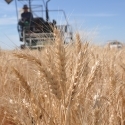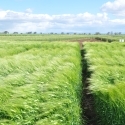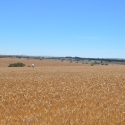08 Feb 2013
Fertilizer Use on Australian Dairy Farms
Dairy Australia Survey 2012
Fertilizer Use in Australian Dairy Farms
The Australian Dairy industry is the third largest rural industry and a through on-farm production and dairy processing is a major rural employer.
Dairying occurs across the high rainfall temperate zones as well as the sub-tropical areas of Australia. The bulk of the production is in the south-east corner of the country, but all states have dairy industries that supply fresh milk to nearby cities and towns.
The dairy industry would account for around 25-30% of all fertilizer use in Australia.
Facts About the Australian Dairy Industry (2010/2011)
· The Australian dairy industry produced 9.1 billion litres of milk.
· There are 6883 dairy farms located across Australia, with 4,588 in Victoria.
· About 1,600,000 dairy cows produce all of Australia’s milk. Average herd size is 230 cows.
· On average, cows produce 5,700 litres of milk per year.
· Milk is used for cheese production (33%), Skim Milk Powder and butter(27%), drinking milk (25%), whole milk powdern (12%), casein/butter (2%) plus other minor uses (1%).
· 43% of dairy products are exported, with Japan, China and southeast Asia the major markets.
· The most common dairy cow breed in Australia is the Holstein Friesian.
· Approximately 40,000 people are directly employed on dairy farms and in manufacturing plants.
(source: Dairy Australia website, dairyaustralia.com.au)
While supplementary feeding with grains is becoming increasingly common, the Australian dairy industry remains predominantly pasture based. So, pasture nutrition is a vital aspect of maintaining a growing industry.
The 2012 Dairying for Tomorrow Survey of Natural Resource Management (Dairy Australia) report provides an overview of the trends in fertilizer use on dairy farms by regions of Australia. Table 1 gives a summary of the types of fertilizer used over the past 12 years on dairy farms.
Table 1: Types of fertilizers used on Australian dairy farms over time. The value is the percentage of farmers who mentioned that fertilizer type.
| Fertilizer Type | 2000 | 2006 | 2012 |
| Superphosphate | 86% | 80% | 74% |
| DAP | 50% | 49% | 46% |
| MAP | 13% | 13% | 16% |
| MOP | 23% | 17% | 22% |
| Urea | 73% | 76% | 76% |
| Off-the shelf blends | 56% | 49% | 46% |
| Prescription blends | 30% | 43% | 35% |
| Organic | 19% | 13% | 22% |
| None | 1% | 3% | |
| Average number of fertilizer types used | 3.5 | 3.5 |
- · Urea and superphosphate continue to be the two most common fertiliser types used on dairy farms (76% and 74% of respondents mentioning respectively).
· The proportion of respondents using superphosphate has decreased significantly since 2006 however, down 6 points to 74%. Similarly, the proportion using prescription blend fertilisers has also dropped significantly, from 43% in 2006 to 35% this year.
· Use of MOP has increased a significant 5 points (now 22% of respondents mentioning) and has returned to 2000 levels (23%).
· The proportion of respondents using organic fertilisers (22%) is significantly higher than 2006 (up 9 points to 22%).
· Over the past 6 years, the proportion of respondents using superphosphate has fallen significantly in Murray Dairy (from 90% to 75%), Dairy NSW (from 78% to 58%) and Tasmania (from 90% to 75%). Conversely, use of organic fertilisers has risen significantly in Murray Dairy (up 10 points to 22%), WestVic Dairy (up 7 points to 16%), GippsDairy (up 8 points to 18%) and Dairy NSW (up 26 points to 36%).
Table 2: Urea use by Dairy Region (2012)
| Region | Average Urea Use (kg/ha) | Median Urea Use (kg/ha) |
| Murray Dairy | 133 | 100 |
| WestVic Dairy | 133 | 100 |
| Gipps Dairy | 203 | 100 |
| Dairy NSW | 93 | 40 |
| Sub-tropical Dairy | 188 | 80 |
| SA Dairy | 109 | 80 |
| Western Dairy | 216 | 100 |
| Dairy Tas | 169 | 101 |
- · Seventy-six percent (76%) of respondents use urea, with an average 155 kgs spread per hectare per year.
· There is substantial variation in the average amount of urea used, from over 200 kgs per hectare per year in Gippsland and WA to under 100kgs per hectare per year in Dairy NSW. Within regions, there is also considerable variation with rates as low as 5 kgs per hectare to more than 500 kgs per hectare.
· Among respondents using urea, the vast majority (88%) cite conditions which prevent them applying urea. This is mainly when paddocks are too wet to drive on (60% of those using urea mentioning), when soil moisture is limiting and conditions are too dry (59%) or when the weather is too hot and/or windy (50% mentioning).
· A very high 95% of Gippsland respondents using urea are prevented from applying it when conditions are not suitable. This proportion is significantly higher than in SDP (82%) and Dairy NSW (84%).
· Respondents aged 18 to 39 years are significantly more likely than those aged 60+ to say there are environmental factors which prevent them applying urea (93% compared to 83%; respondents aged 40 to 59 years – 89%).
Also in this survey, dairy farmers were asked about how they made assessments of the need for fertilizers. In 2012, 82% used soil tests and 16% were using tissue tests. Farmers were relying on their own observations and past experience, but less so on their fertilizer supplier. 57% considered advice from independent consultants, and there was good confidence in the advice provided. There is substantial variation in the methods used across regions, with the highest use of tissue testing in Western Australia. Nutrient budgets were used by 30% of farmers nationally, but nearly half of Tasmanian dairy farmers use budgets.




